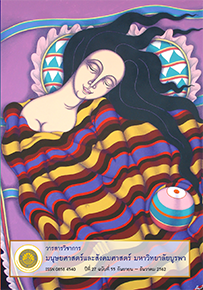The Set of Enlightening Signs for Enhancing Positive Attitude towards Blind People: A Study of Dialogue in the Dark Exhibition
Main Article Content
Abstract
This study aimed at analyzing the signification signs that the visitors received the message from Dialogue in the Dark Exhibition-changing their attitudes and perceptions toward blind people from pity into acceptance and understanding. Semiotics was employed to analyze two data sources, namely, data collected from the researcher’s participatory observation, and data collected through in-depth interviews from people participating in the exhibition. The descriptive analysis was used through transformative learnings. The study found 4 key signs, that changed the participants’ pity to acceptance and understanding, included 1) dialogue, 2) darkness, 3) guides, and 4) visitors that assisted to change the visitors’ attitudes and perceptions toward blind people. All these signs were the key factors to support transformative learning process among them. The results from the interviews also revealed that the visitors gained a better understanding, respect, and acceptance toward blind people; however, they still had a pity feeling toward them. In the future, to continue changing the people’s feeling toward the blind, we could convey the message through other activities that could completely change the attitude of compassion for the visually impaired.
Downloads
Article Details
บทความทุกบทความเป็นลิขสิทธิ์ของวารสารวิชาการมนุษยศาสตร์และสังคมศาสตร์ มหาวิทยาลัยบูรพาเท่านั้น
References
กิตติพงศ์ สุทธิ. (2549). คำนิยม. ใน วีระศักดิ์ จันทร์ส่งแสง (บรรณาธิการ). เต้นรำในความมืด: หลากหลายโศกนาฏกรรมของผู้พิการทางสายตา (หน้า 6-7). นนทบุรี: แผนงานสร้างเสริมสุขภาพคนพิการในสังคมไทย ศูนย์สิรินธรเพื่อการฟื้นฟูสมรรถภาพทางการแพทย์แห่งชาติ.
จัตุรัสวิทยาศาสตร์. (2555). นิทรรศการบทเรียนในความมืด. วันที่ค้นข้อมูล 31 สิงหาคม 2559, จาก http://www.nsm.or.th/index.php
จีรพร แผ้วกิ่ง และโสภา อ่อนโอภาส. (2546). รายงานวิจัยย่อยฉบับสมบูรณ์วิถีชีวิตคนพิการทางสายตาในเขตกรุงเทพมหานคร. กรุงเทพฯ: สำนักงานกองทุนสนับสนุนการวิจัย.
ดารุณี อุทัยรัตนกิจ. (2538). การศึกษาสำหรับคนพิการในยุคโลกาภิวัฒน์. กรุงเทพฯ: สถาบันพัฒนาคุณภาพวิชาการ
ถนอมนวล หิรัญเทพ. (2551). วาทกรรมความพิการในเรื่องเล่าสมัยใหม่ของไทย. อักษรศาสตรดุษฎีบัณฑิต, สาขาวิชาวรรณคดีและวรรณคดีเปรียบเทียบ, คณะอักษรศาสตร์, จุฬาลงกรณ์มหาวิทยาลัย.
ปรียาพร วงศ์อนุตรโรจน์. (2548). จิตวิทยาการศึกษา. กรุงเทพฯ: ศูนย์สื่อเสริมการสอน.
พธู คูศรีพิทักษ์. (2556). การสื่อสารเพื่อการเรียนรู้เชิงปริวรรตในนิทรรศการชั่วคราวของมิวเซียมสยาม. ปรัชญาดุษฎีบัณฑิต, สาขาวิชานิเทศศาสตร์, คณะนิเทศศาสตร์, มหาวิทยาลัยรังสิต.
พวงแก้ว กิจธรรม. (2557). ทันสื่อล้อเลียนคนพิการ สื่อ...กับการสร้างสังคม “พัฒนานิยม” เพื่อคุณภาพชีวิตคนพิการ. กรุงเทพ: มูลนิธิพัฒนาคนพิการไทย.
วรินทรา ศิริสุทธิกุล. (2557). บทเรียนในความมืด Dialogue in the Dark. จุลสารส่งเสริมการวิจัยบริหารธุรกิจ. (จุลสาร). กรุงเทพฯ: ฝ่ายวิจัยภาควิชาบริหารธุรกิจ คณะสังคมศาสตร์ มหาวิทยาลัยศรีนครินทรวิโรฒ.
วิจารณ์ พานิช. (2558). เรียนรู้สู่การเปลี่ยนแปลง. กรุงเทพฯ: มูลนิธิสยามกัมมาจล.
วิวรรธน์ จันทร์เทพย์. 2548. การจัดแสดงและนิทรรศการ. ราชบุรี: คณะครุศาสตร์ มหาวิทยาลัยราชภัฏหมู่บ้านจอมบึง.
วีระศักดิ์ จันทร์ส่งแสง. (2549). เต้นรำในความมืด: หลากหลายโศกนาฏกรรมของผู้พิการทางสายตา. นนทบุรี: แผนงานสร้างเสริมสุขภาพคนพิการในสังคมไทย ศูนย์สิรินธรเพื่อการฟื้นฟูสมรรถภาพทางการแพทย์แห่งชาติ.
เสาวนีย์ สีสอง. (2556). สถานภาพและบทบาทตัวละครพิการในนวนิยายร่วมสมัย: ภาพสะท้อนสถานภาพคนพิการในสังคมไทย. วารสารมนุษย์ศาสตร์และสังคมศาสตร์ มหาวิทยาลัยบูรพา, 21(37), 297-232.
อนุรักษ์ จันทร์ดำ. (2559). การประกอบสร้างชุดสัญญะแห่งการเรียนรู้เพื่อสร้างทัศนคติเชิงบวกต่อบุคคลพิการทางสายตาของนิทรรศการบทเรียนในความมืด. วิทยานิพนธ์ปริญญามหาบัณฑิต, คณะนิเทศศาสตร์และนวัตกรรมการจัดการ, สถาบันบัณฑิต พัฒนบริหารศาสตร์.
Edmonds, L. (2005). Disabled People and Development. Poverty and social development Papers No.12. June 2005. Asian Development Bank.
Hodge, H. (1998). A semiotic analysis of the Australian Museum’s Indigenous Australians: Australia’s First Peoples Exhibition. University of Western Sydney.
Johns, C. (2000). Becoming a Reflective Practitioner. London: Blackwell Science.
Mezirow, J. (1991). Transformative Dimensions of Adult Learning. San Francisco: Jossey-Bass.
Mezirow, J. and others. (1990). Fostering Critical Reflection in Adulthood a Guide to Transformative and Emancipatory Learning. San Francisco: Jossey-Bass A Wiley Company.
Sawyer, B. and others. (2002). Adult museum programs, designing meaningful experiences. Rowman Altamira.
Wong, F. K., Loke, A. Y., Wong, M., Tse, H., Kan, E., and Kember, D. (1997). An Action Research Study into the Development of Nurses as Reflective Practitioners. Journal of Nursing Education. 36(10): 476-481.

